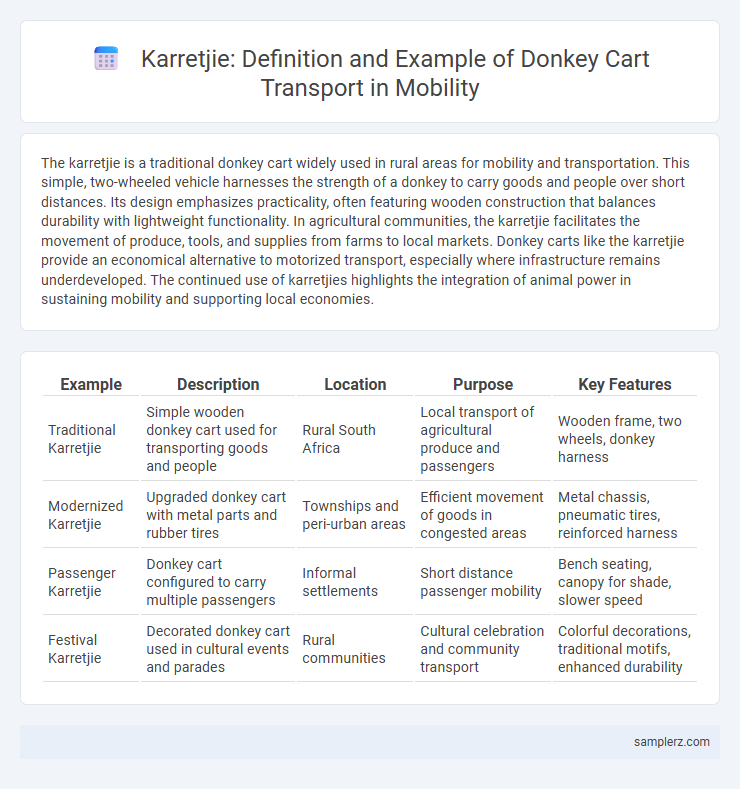The karretjie is a traditional donkey cart widely used in rural areas for mobility and transportation. This simple, two-wheeled vehicle harnesses the strength of a donkey to carry goods and people over short distances. Its design emphasizes practicality, often featuring wooden construction that balances durability with lightweight functionality. In agricultural communities, the karretjie facilitates the movement of produce, tools, and supplies from farms to local markets. Donkey carts like the karretjie provide an economical alternative to motorized transport, especially where infrastructure remains underdeveloped. The continued use of karretjies highlights the integration of animal power in sustaining mobility and supporting local economies.
Table of Comparison
| Example | Description | Location | Purpose | Key Features |
|---|---|---|---|---|
| Traditional Karretjie | Simple wooden donkey cart used for transporting goods and people | Rural South Africa | Local transport of agricultural produce and passengers | Wooden frame, two wheels, donkey harness |
| Modernized Karretjie | Upgraded donkey cart with metal parts and rubber tires | Townships and peri-urban areas | Efficient movement of goods in congested areas | Metal chassis, pneumatic tires, reinforced harness |
| Passenger Karretjie | Donkey cart configured to carry multiple passengers | Informal settlements | Short distance passenger mobility | Bench seating, canopy for shade, slower speed |
| Festival Karretjie | Decorated donkey cart used in cultural events and parades | Rural communities | Cultural celebration and community transport | Colorful decorations, traditional motifs, enhanced durability |
Traditional Roots: The History of the Karretjie Donkey Cart
The karretjie donkey cart traces its origins to rural South Africa, where it has long served as a vital mode of transport for agricultural and domestic purposes. Traditionally crafted from locally sourced wood and reinforced with metal, the karretjie embodies sustainable mobility, reflecting the resourcefulness and cultural heritage of farming communities. Its continued use highlights the enduring relevance of animal-drawn vehicles in regions with limited access to modern transportation infrastructure.
Engineering Simplicity: Structure and Design of a Karretjie
The karretjie donkey cart exemplifies engineering simplicity through its straightforward wooden frame, minimal joint connections, and durable axle design, enabling easy maintenance and repair in rural settings. Its lightweight structure optimizes load capacity while maintaining stability on uneven terrains, reflecting efficient use of locally sourced materials like hardwood and metal reinforcements. The open cart design maximizes functional space without compromising mobility, highlighting practical engineering tailored to transport needs in agricultural and remote communities.
Daily Life: How Karretjie Transforms Rural Mobility
The karretjie, a traditional donkey cart, revolutionizes rural mobility by providing an affordable and reliable means of transport for daily tasks such as market trips, school commutes, and agricultural work. Its simple design allows for easy maintenance and adaptability on rough terrains common in rural areas, significantly improving access to essential services. This mode of transportation enhances the economic and social connectivity of remote communities, fostering greater independence and quality of life.
Sustainable Transport: Eco-Friendly Benefits of Donkey Carts
Donkey carts, exemplified by the karretjie in rural transport, offer sustainable mobility solutions with minimal environmental impact. These animal-powered vehicles produce zero emissions, reduce reliance on fossil fuels, and promote eco-friendly transport in low-income and agricultural communities. The karretjie's simple design and renewable energy source contribute to carbon footprint reduction and support biodiversity conservation in local ecosystems.
Modern Day Karretjie: Adapting to Contemporary Needs
Modern day karretjies have evolved with reinforced steel frames and electric-assist motors to enhance efficiency in urban and rural transport. Farmers and small-scale vendors utilize these adapted donkey carts for eco-friendly, cost-effective delivery and mobility solutions. Integration of GPS tracking systems further optimizes route management, reflecting a seamless blend of tradition and technology in contemporary mobility.
Socioeconomic Impact: Supporting Local Livelihoods
The karretjie in donkey cart transport plays a crucial role in supporting local livelihoods by providing affordable and accessible mobility for small-scale farmers and traders in rural areas. This traditional mode of transport enables the efficient movement of goods and agricultural produce to local markets, fostering economic activity and strengthening community resilience. The continued use of karretjies contributes to preserving cultural heritage while generating income opportunities for families dependent on low-cost transport solutions.
Cultural Significance: The Karretjie in Heritage and Identity
The karretjie, a traditional donkey cart, holds deep cultural significance in rural South African communities as a symbol of heritage and identity. Often handcrafted and passed down through generations, it represents resilience, resourcefulness, and connection to the land. This mode of transport not only facilitates mobility but also preserves cultural narratives and sustains local customs.
Challenges Facing Karretjie Transport Today
Karretjie transport, traditionally reliant on donkey-drawn carts, faces challenges such as limited speed and low load capacity, restricting efficiency in modern logistics. The lack of infrastructure and safety regulations for animal-drawn vehicles increases risks for drivers and pedestrians alike. Environmental concerns and animal welfare issues also pressure communities to seek sustainable alternatives in rural mobility solutions.
Community Stories: Voices from Karretjie Owners
Karretjie owners share valuable insights about resilience and tradition in donkey cart transport, emphasizing the role these simple vehicles play in rural mobility and local economies. Stories highlight how karretjies enable access to markets, schools, and health services, fostering community cohesion and sustainable transport solutions. These narratives reflect a deep connection between cultural heritage and practical mobility needs in underserved areas.
The Future of Donkey Cart Mobility: Innovations and Trends
The future of donkey cart mobility hinges on integrating eco-friendly technologies such as solar-powered lighting and GPS tracking systems to enhance efficiency and safety in rural transport. Innovations in lightweight, durable materials for cart construction aim to improve load capacity and reduce animal strain while smart sensors monitor the well-being of donkeys in real time. Emerging trends emphasize sustainable practices that balance traditional donkey cart usage with modern mobility solutions to boost productivity and preserve animal welfare.

example of karretjie in donkey cart transport Infographic
 samplerz.com
samplerz.com